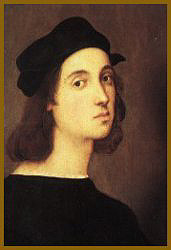 Raphael
(Raffaello Santi)
Raphael
(Raffaello Santi)
Imagine the young art student who quickly surpasses every teacher -- a student who could reproduce his master's style so well that only the most delicate forensic tests applied several hundred years later could discriminate between the student's and the master's work. Imagine a young painter who got a sneak preview of Michelangelo's Sistine Chapel ceiling and infuriated Michelangelo by preempting its unveiling: he more quickly produced a major work of his own incorporating Michelangelo's new dynamic style. Imagine an artist who was so productive in a short life that even modern computerized catalogues fail to encompass his work and whose work so changed artistic conventions that for centuries other painters (those generations of "mannerists") tried, with only slight success, to paint "in the manner of" Raphael.
Imagine a person whose influence on all subsequent art was so great that the "Pre-Raphaelite" reactionaries, three centuries later in the 19th century, used his name to define what they hated. They absurdly thought they could defeat renaissance "decadence" and return art to "purity" and "primitivism". (Unfortunately, in the 20th century other slightly-talented primitives actually succeeded -- Picasso, Dali, Calder, Warhol, Grandma Moses, and Coco the Chimp all managed major sales of their vacuous work to international collectors and museums.)
Then imagine the person who invented the study of Roman antiquities. Imagine Raphael, as the Pope's chief archeologist, having himself lowered into the "grottos" of Nero's Domus Aurea, and emerging with new ideas and yet another artistic style known until today as "grotesque."
Finally, imagine a young man of over-large sensual appetites who kept multiple simultaneous mistresses. When ordered to settle down by Cardinal Bibiana, one of his patrons, he agreed to a betrothal to the Cardinal's niece. The betrothal lasted six years and outlasted the girl -- she died, he regretted, but he played on. His purposefully erotic portrait of his last and favorite mistress, a baker's daughter, "La Fornarina" (puns abound), is the most famous painting in the Palazzo Barberini where it has hung since at least 1642.
Raphael died on April 6, 1520, his 37th birthday, after an unusually exhausting and feverish debauch -- his doctors, thinking he had caught a chill and following the science of their time, bled him in his already weakened state and undoubtedly killed him. On his deathbed he bequeathed money for an altar in S. Maria Rotunda (the Pantheon). His bones are under the altar, and to its right is a plaque, which he requested, asking for prayers for his long-time but unrequited betrothed, Maria Bibiana. Contrary to rumor and to what some guides will tell you, neither she nor any of Raphael's mistresses rest in the Pantheon.
Internet links:
"La Fornarina" -- "The Bakery Girl",
daughter of a Sienese baker:
http://www.artchive.com/artchive/R/raphael/raphael_fornarina.jpg.html
Other Raphael works:
http://www.spectrumvoice.com/art/artists/major/r/raphael.htm
Raphael's works with comments from
his biography by Georgio Vasari:
http://easyweb.easynet.co.uk/giorgio.vasari/raphael/raphael.htm
Raphael's Vatican Stanze and Loggia
http://christusrex.org/www1/stanzas/0-Raphael.html
EuroWeb Gallery:
http://gallery.euroweb.hu/bio/r/raphael/biograph.html
Bio and Images from the Artchive:
http://www.artchive.com/artchive/R/raphael.html
Vasari's biography of Rafael:
http://rubens.anu.edu.au/imageserve/texts//vasari/vasari.raphael.html
Catholic Encyclopedia on "the most
famous name in the history of painting":
http://www.newadvent.org/cathen/12640c.htm